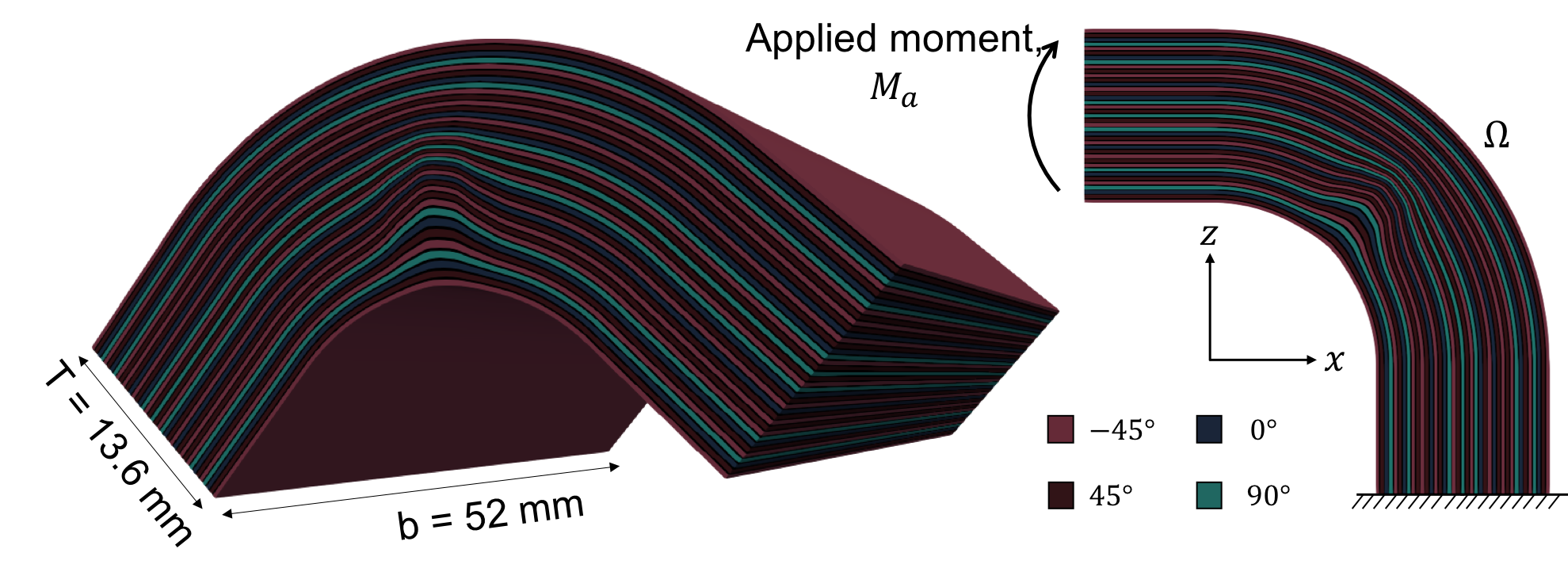Composite material with random wrinkle¶
Overview¶
This model implements the 3D anisotropic linear elasticity equations for a composite part with randomised wrinkle. The maximum deflection of the part is estimated by embedding a wrinkle into a high fidelity FE simulation using the high performance toolbox dune-composites.

Run¶
docker run -it -p 4242:4242 linusseelinger/model-dune-composites:latest
Properties¶
Model |
Description |
|---|---|
forward |
Linear elasticity |
forward¶
Mapping |
Dimensions |
Description |
|---|---|---|
input |
[346000] |
Coefficients of a Karhunen Loeve expansion of a wrinkle. |
output |
[1] |
Maximum deflection of the composite part. |
Feature |
Supported |
|---|---|
Evaluate |
True |
Gradient |
False |
ApplyJacobian |
False |
ApplyHessian |
False |
Config |
Type |
Default |
Description |
|---|---|---|---|
ranks |
int |
2 |
Number of MPI ranks (i.e. parallel processes) to be used. |
stack |
string |
“example2.csv” |
Path to the stacking sequence to be run. |
Mount directories¶
Mount directory |
Purpose |
|---|---|
None |
Source code¶
Description¶
In the simulation the composite strength of a corner part with a wrinkle is modeled and the maximum deflection is returned. The stacking sequence of the composite corner part can be set using the “stack” configuration parameter, by default a 12 layer setup is used. A simplified model for a 3D bending test was used. The curved composite parts were modelled with shortened limbs of length 10 mm. A unit moment was applied to the end of one limb using a multi-point constraint, with homogeneous Dirichlet conditions applied at the end of the opposite limb. This gives the same stress field towards the apex of the curved section as a full 3D bending test. The analysis assumes standard anisotropic 3D linear elasticity and further details on the numerical model and discretisation can be found in [1].
The wrinkle defect is defined by a deformation field \(W:\Omega \rightarrow \mathbb R^3\) mapping a composite component from a pristine state to the defected state.
The wrinkles are defined by the wrinkle functions
where \(g_i(x_i)\) are decay functions , \(f_i(x_1,\lambda)\) are the first \(N_w\) Karhunen-Lo’{e}ve (KL) modes parameterized by the length scale \(\lambda\) and \(a_i\) the amplitudes. The amplitude modes and the length scale can be taken as random variables, so that the stochastic vector is defined by \(\boldsymbol \xi = [a_1,a_2,\ldots,a_{N_w},\lambda]^T\). The wrinkles are prismatic in \(x_2\), e.g. the wrinkle function is assumed to have no \(x_2\) dependency. For more details on the wrinkle representation see [2].
References¶
[1] Anne Reinarz, Tim Dodwell, Tim Fletcher, Linus Seelinger, Richard Butler, Robert Scheichl, Dune-composites – A new framework for high-performance finite element modelling of laminates, Composite Structures, 2018.
[2] Anhad Sandhu and Anne Reinarz and Tim Dodwell, A Bayesian framework for assessing the strength distribution of composite structures with random defects, Composite Structures, 2018.